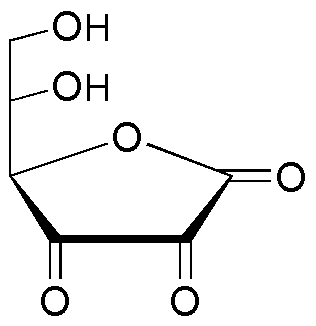Dehydroascorbic acid is widely utilized in research focused on:
- Food Preservation: This compound acts as a powerful antioxidant, helping to extend the shelf life of food products by preventing oxidation, which can lead to spoilage. It's commonly used in the food industry to maintain the quality of fruits and vegetables.
- Cosmetic Formulations: Due to its skin-brightening properties, dehydroascorbic acid is incorporated into skincare products. It helps in reducing pigmentation and improving skin texture, making it a popular ingredient in serums and creams.
- Pharmaceutical Applications: This compound is utilized in the development of various medications, particularly for its role in enhancing the stability of vitamin C in formulations, which is crucial for maintaining efficacy in therapeutic products.
- Biochemical Research: Researchers use dehydroascorbic acid in studies related to cellular metabolism and oxidative stress. Its ability to easily convert back to ascorbic acid makes it valuable for investigating vitamin C's biological roles.
- Diagnostic Tools: In clinical settings, dehydroascorbic acid is used in assays and tests to measure vitamin C levels in biological samples, aiding in the diagnosis of deficiencies and related health issues.
General Information
Properties
Safety and Regulations
Applications
Dehydroascorbic acid is widely utilized in research focused on:
- Food Preservation: This compound acts as a powerful antioxidant, helping to extend the shelf life of food products by preventing oxidation, which can lead to spoilage. It's commonly used in the food industry to maintain the quality of fruits and vegetables.
- Cosmetic Formulations: Due to its skin-brightening properties, dehydroascorbic acid is incorporated into skincare products. It helps in reducing pigmentation and improving skin texture, making it a popular ingredient in serums and creams.
- Pharmaceutical Applications: This compound is utilized in the development of various medications, particularly for its role in enhancing the stability of vitamin C in formulations, which is crucial for maintaining efficacy in therapeutic products.
- Biochemical Research: Researchers use dehydroascorbic acid in studies related to cellular metabolism and oxidative stress. Its ability to easily convert back to ascorbic acid makes it valuable for investigating vitamin C's biological roles.
- Diagnostic Tools: In clinical settings, dehydroascorbic acid is used in assays and tests to measure vitamin C levels in biological samples, aiding in the diagnosis of deficiencies and related health issues.
Documents
Safety Data Sheets (SDS)
The SDS provides comprehensive safety information on handling, storage, and disposal of the product.
Product Specification (PS)
The PS provides a comprehensive breakdown of the product’s properties, including chemical composition, physical state, purity, and storage requirements. It also details acceptable quality ranges and the product's intended applications.
Certificates of Analysis (COA)
Search for Certificates of Analysis (COA) by entering the products Lot Number. Lot and Batch Numbers can be found on a product’s label following the words ‘Lot’ or ‘Batch’.
*Catalog Number
*Lot Number
Certificates Of Origin (COO)
This COO confirms the country where the product was manufactured, and also details the materials and components used in it and whether it is derived from natural, synthetic, or other specific sources. This certificate may be required for customs, trade, and regulatory compliance.
*Catalog Number
*Lot Number
Safety Data Sheets (SDS)
The SDS provides comprehensive safety information on handling, storage, and disposal of the product.
DownloadProduct Specification (PS)
The PS provides a comprehensive breakdown of the product’s properties, including chemical composition, physical state, purity, and storage requirements. It also details acceptable quality ranges and the product's intended applications.
DownloadCertificates of Analysis (COA)
Search for Certificates of Analysis (COA) by entering the products Lot Number. Lot and Batch Numbers can be found on a product’s label following the words ‘Lot’ or ‘Batch’.
*Catalog Number
*Lot Number
Certificates Of Origin (COO)
This COO confirms the country where the product was manufactured, and also details the materials and components used in it and whether it is derived from natural, synthetic, or other specific sources. This certificate may be required for customs, trade, and regulatory compliance.


